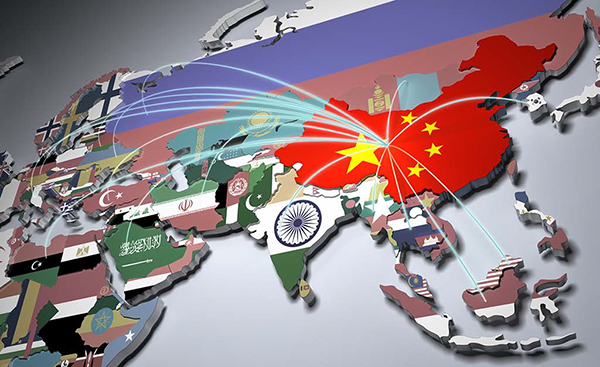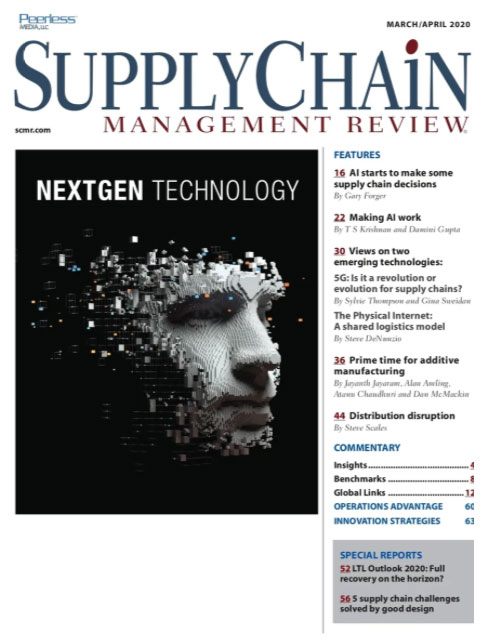Sorry, but your login has failed. Please recheck your login information and resubmit. If your subscription has expired, renew here.
March-April 2020
Are you ready for NextGen technologies? Just the other day, I had the opportunity to tour one of Amazon’s highly automated robotic fulfillment centers. I expected to be dazzled—and I was. But it wasn’t because of the automation. The tour was a reminder that there’s no question that NextGen technologies such as Artificial Intelligence, blockchain, robotics, 3D printing and 5G are going to be the differentiators in tomorrow’s supply chain. The question is: Are you ready? Browse this issue archive.Need Help? Contact customer service 847-559-7581 More options
Most supply chains are historical accidents… really. Think about it: rarely is a business started and launched from a supply chain set of capabilities. Granted, many logistics service companies have instances where supply chain came first, but they’re harder to find.
As supply chain practitioners, we’re always “catching up” to our organization’s latest strategy or sales and marketing initiative. The latest example is omni-channel strategy. In this case, the front end of the sales engine was created as a slick method to digitize the product offering (which, by the way, kept expanding) to offer new ways and options for consumers to shop, order and have their purchase delivered—instantly. The trouble is that supply chain professionals ended up with a new fulfillment demographic and requirements that affected cost and capacity to execute. And, setting up new network nodes and transportation capabilities to satisfy the delivery expectations is not trivial.
For most companies, this is the new normal. New capabilities were developed; partners were brought on board to execute; and new warehouse and transportation management systems were implemented. All of that, of course, after the fact and decidedly in a hurry, essentially creating the historical accident that we now call omni-channel fulfillment.

This complete article is available to subscribers only.
Log in now for full access or start your PLUS+ subscription for instant access.
SC
MR
Sorry, but your login has failed. Please recheck your login information and resubmit. If your subscription has expired, renew here.
March-April 2020
Are you ready for NextGen technologies? Just the other day, I had the opportunity to tour one of Amazon’s highly automated robotic fulfillment centers. I expected to be dazzled—and I was. But it wasn’t because… Browse this issue archive. Access your online digital edition. Download a PDF file of the March-April 2020 issue.Most supply chains are historical accidents… really. Think about it: rarely is a business started and launched from a supply chain set of capabilities. Granted, many logistics service companies have instances where supply chain came first, but they're harder to find.
As supply chain practitioners, we're always “catching up” to our organization's latest strategy or sales and marketing initiative. The latest example is omni-channel strategy. In this case, the front end of the sales engine was created as a slick method to digitize the product offering (which, by the way, kept expanding) to offer new ways and options for consumers to shop, order and have their purchase delivered—instantly. The trouble is that supply chain professionals ended up with a new fulfillment demographic and requirements that affected cost and capacity to execute. And, setting up new network nodes and transportation capabilities to satisfy the delivery expectations is not trivial.
For most companies, this is the new normal. New capabilities were developed; partners were brought on board to execute; and new warehouse and transportation management systems were implemented. All of that, of course, after the fact and decidedly in a hurry, essentially creating the historical accident that we now call omni-channel fulfillment.
SC
MR


Latest Supply Chain News
- AI, virtual reality is bringing experiential learning into the modern age
- Humanoid robots’ place in an intralogistics smart robot strategy
- Tips for CIOs to overcome technology talent acquisition troubles
- There is still work to do to achieve supply chain stability
- Blooming success: The vital role of S&OE in nurturing global supply chains
- More News
Latest Resources

 Explore
Explore
Business Management News
- AI, virtual reality is bringing experiential learning into the modern age
- Tips for CIOs to overcome technology talent acquisition troubles
- There is still work to do to achieve supply chain stability
- Blooming success: The vital role of S&OE in nurturing global supply chains
- Supply chain salaries, job satisfaction on the rise
- How one small part held up shipments of thousands of autos
- More Business Management
Latest Business Management Resources

Subscribe

Supply Chain Management Review delivers the best industry content.

Editors’ Picks






